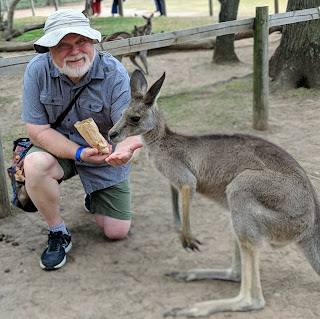Lamington National Park
Sunday morning, we all met at a storage facility in
Brisbane. All the homestay families
brought their students to meet there and goodbyes were said. I heard many of the families telling Nat, our
GED leader, that they really enjoyed the students and that they were great
people. Glad to hear that. We (with LC’s help) rented a storage unit for
the students to leave many of their items that they won’t need for the next 5
weeks of camping and travel. We needed
to pack light. After storing their
things the students helped Nat load a U-haul truck with all the supplies we’d need for
camping at Lamington. It’s quite
a process, which GED has streamlined very well.
We brought up 14 tents, cots and pads and chairs for all, tables and
benches, a kitchen tent and a dining tent.
Also, plates and silverware, research books about the plants and animals
in the rainforest, traps, scientific tools for measuring things like humidity,
height of a tree, etc. If you’ve camped
before, you know that there are so many items to bring. Well, that amount intensifies when you’re
also doing scientific studies while camping!
After a lunch stop at a small town, Canungra, for a pasty, pastry and a
meat pie, we arrived at Lamington National Park, Green Mountain
campground. It’s right next to
O’reilly’s Resort.
One very interesting thing about Lamington is that there are
pockets of temperate rainforest, right next to eucalypt forests. We took
a bushwalk thru the rainforest and could tell a distinction almost right
away. The border zone/ecotome is only about 10
metres from one type of forest to the other, fascinating. We learned about so many interesting trees, plants, invertebrates, birds, pademelons and bioluminescent things!
Erik is pointing to the 2 types of forests. His left hand is pointing towards the rainforest and his right towards the sclerophyll/eucalypt forest.
Strangler figs are a very interesting tree. This type, Moreton Bay Fig, is endemic to Australia. This second picture shows one that is about 40 years old, but it still looks like a sapling. It starts with a
tiny seed in the canopy. The roots grow down to the forest floor where they take root and begin to take nutrients from the soil. Gradually the roots wrap around the host tree, widen, and slowly form a lattice work that surrounds the hosts trunk, often killing the host tree, leaving a hollow space inside. Super interesting!
tiny seed in the canopy. The roots grow down to the forest floor where they take root and begin to take nutrients from the soil. Gradually the roots wrap around the host tree, widen, and slowly form a lattice work that surrounds the hosts trunk, often killing the host tree, leaving a hollow space inside. Super interesting!
Here you can see 3 types of epiphytes, bird nest, then orchids, then stag horn. The highly poisonous stinging tree is growing in the bird nest epiphyte. Thankfully none of us touched one of these. Our biologist, Peter, rubbed against one years ago and he didn't recover completely for a year and a half!
One early morning we had a bird walk with Duncan Fowler, his real name! Actually, as he put it, it was more of a bird stand. We could hear and see so many awesome birds right at our campsite that we didn't have to walk far. We saw 2 quite rare birds: rifle bird (a bird of paradise) and Albert lyre bird. The lyre bird is a mimic, the mother teaches the babies. They are the largest songbird in the world and scratch and claw at the undergrowth-they help reduce the fireload in a forest by 30%! We saw and heard many other unique and interesting birds. The whip bird, brush turkey, bower bird, king parrot, honey eater, rainbow lorakeet, gullahs, fairy wren and cat bird, to name a few. The bird calls and songs were gorgeous and quite noisy at times.
This is the remant of a Regent Bowerbird courting den. This species finds anything blue to decorate the area with in order to attract a female. Some bower birds just turn over 10 leaves and call it good, according to Mr Fowler!
We went on a tree walk and climbed 24 metres above ground for this photo. Erik went up the next level, 30 metres above ground. The sunsets at Lamington were spectacular.
One of the highlights for us was the bioluminescence. One night while Group A was setting live traps (to catch Bush Rats, Brush tailed possum and king crickets), Isabelle asked Erik what that light up the hill was. It turns out it was a tree surrounded by ghost mushrooms. They were a bright green! So, so cool! The rangers said that they only last a few weeks. Sure enough, 3 days later, Erik and Nat went back with several more people and they were all melted away without a sign of the glowing! We also went one night on a bushwalk down to a creek to see glowworms. We weren't sure any would be there because it'd been quite dry, but thankfully they were! So awesome! Unbelievable. We sat peacefully in the dark looking at the glowworms, which looked like the starry night sky. Then Nat suggested we sing, so we quietly sang "I Love the Mountains", with adding glowworms instead of fireflies. What fun!

































































